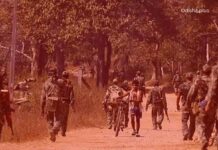Partha Sarathi Ghosh
The recent violence and ongoing conflict impacting socio economic life in Manipur is a cause for concern requiring attention from all quarters of the society
India has always been a land of diversity, and its guiding principles accept universal brotherhood. Sometimes, maintaining a striking balance among distinct disparities becomes cumbersome. Through the ages, conflict and its resolutions have been part and parcel of our lives. An earnest effort in this regard requires both dialogue and force simultaneously.

The recent violent conflict and tragedies in Manipur are deeply saddening and tragic and require urgent attention from all sectors of society. If peaceful coexistence is not possible to maintain at the earliest, there is bound to be immense suffering, displacement, and long-term emotional scars.
Manipur is a state in northeastern India that is home to various ethnic communities, each with its own distinct cultural and historical background that leads to its own unique socio-political challenges. The state of Manipur has a rich ancient history. It is believed to have been a part of the larger Kangleipak kingdom, which was an independent and powerful state during the pre-colonial period. The kingdom of Kangleipak had its capital at Kangla Fort in present-day Imphal. During the medieval period, Manipur saw several dynasties rule the region.
One of the notable dynasties was the Ningthouja dynasty, which ruled for a considerable amount of time. In the 19th century, Manipur came under British influence, and in 1891, it was formally annexed by the British Empire after the Anglo-Manipur War. The British rule significantly impacted the political and social fabric of Manipur. After India gained independence from British rule in 1947, initially it was a princely state, but later, in 1949, it merged with India as a full-fledged state. Manipur became a Union Territory in 1956 and later achieved full statehood on January 21, 1972.
To understand Manipur better, we have to understand its people, their lives, and their concerns. Out of the many ethnic communities, the most prominent of them is the Meitei, which is the largest community in the region and plays a crucial role in shaping the state’s identity and history. Meitei society is organized into clans and has a matrilineal kinship system, where inheritance and ancestral ties are traced through the mother’s line. They speak Meiteilon, also known as Manipuri, which is a Tibeto-Burman language. They are known for their unique dance forms, including the classical Manipuri dance, which is famous for its graceful movements and storytelling elements.
The Naga Community is a group of various tribal ethnicities known for their distinct cultures, languages, and traditional practices, residing in the northeastern region of India. They comprise various tribes, including the Angami, Ao, Tangkhul, Zeme, Rongmei, Poumai, and others. They have also resisted foreign invasions and influences. During the British colonial period, the Nagas fiercely opposed British rule. After India gained independence in 1947, demands for Naga sovereignty and self-determination escalated, leading to an armed struggle for independence that continued for several decades.
The Kuki community is another significant ethnic group, having a diverse group with various sub-tribes and clans, such as Thadou, Paite, Simte, Gangte, Hmar, Zou, and many more, each with its own distinct cultural practices and languages. In Manipur, the Kuki community has a long and complex history. The Kuki people primarily inhabit the hilly and mountainous regions of northeastern India. In modern times, the Kuki community faces challenges related to development, infrastructure, education, and preserving their unique cultural identity in the face of modernization and globalization.
In addition to Meitei, Naga, and Kuki communities, there are a number of relatively smaller ethnic communities found in Manipur, like Pangal, Hmar, Kom, Mizo, Kabui, Maram Maring, Animol, Anal, Chothe, Monsang, Moyon, Ralte, Tarao, and others, each with its own unique cultural identity, adding to the state’s rich diversity.
The bone of contention lies in the unequal distribution of land, territorial integrity, inter-ethnic tensions and conflicts over resources, political rights, power sharing among different communities, several insurgent groups seeking regional autonomy, and issues concerning specific communities.
The territorial advantages lay in the hands of the tribal population in general and the Naga and Kuki communities in particular. Out of the total population, the tribal populations constitute around 42 percent, but they reside in hill areas, which constitute 90 percent of the total area of Manipur, whereas the Meitei communities, the predominant ethnic group of Manipur, are now primarily settled in the Imphal Valley region, which constitutes only 10 percent of the total territory of the state.
The Meitei communities are barred from a number of constitutional rights as they do not fall under the Scheduled Tribes group. They cannot settle in hilly areas, even if they wish to, because of special constitutional privileges granted to the Scheduled Tribe of Manipur under the State’s Land Reform Act. On the other hand, there are no restrictions for the Kukis and Nagas to settle in the valley. Now, around 57 percent of the Manipur population resides in Imphal Valley, with Meitei being the dominant. This is one of the key reasons for the intolerance between the Meitei and the hill tribes.
The Political advantage lies in the hands of Meitei communities, with the valley enjoying 40 out of the 60 constituencies in the state because of its sizable population. The Meitei have been controlling the state and its apparatus. There is widespread resentment among the tribal groups over this political factor. Because there are fewer political representatives in the state legislative assembly, their effectiveness in molding political decisions is minimal. There have been disagreements over seat allocations. Frequent conflicts have contributed to mistrust and animosity between the communities. This also substantially contributed to the ongoing unrest.
In addition to this, earlier Manipur also witnessed various ethnic and political tensions, leading to the emergence of several insurgent groups in the region. The state has experienced periods of instability and violence due to these conflicts.
The immediate reason for the prevalent widespread violence in Manipur could have been attributed to the recent Manipur High Court’s judgment on March 27, 2023, directing the state government to consider the inclusion of the Meitei communities in the Schedule Tribe list within four weeks and send a recommendation to the union government for its consideration. Tribal people are not happy with the judgment on the apprehension that the majority of Meitei communities may be able to settle anywhere in the state, and thereby they may lose their distinct identity. Resentment has also come to the fore as the result of a government order on protected forest land.
The state government wants to free illegally occupied forest land under the Manipur Forest Rules 2021, which empowers the state government to evict any encroachment on forest land. In this case, the state is reportedly using the word encroachment, which the tribal population terms settlement. Thus, the eviction drive is being lamented as an attempt to deprive the tribal communities of their ancestral lands. This also adds fuel to the fire.
Whatever the reason, we cannot remain silent spectators for a long period of time. With the recent developments, it is presumed that perhaps the region has not received adequate attention in terms of infrastructure development, which could have an impact on overall socio-economic growth. The preservation of the region’s cultural identity and autonomy needs to be adequately safeguarded.
There is an urgent need to address the root cause of conflict, be it by tackling insurgencies, inter-ethnic tensions, territorial disputes, clashes over resources, or better participation in the political process. The coexistence of the three dominant communities – Meitei, Kuki, and Naga – is largely disrupted, as tribes in the hills are apprehensive about losing their exclusive domain over the highlands. This crisis requires creative, compassionate, and realistic solutions.
(The author is Head of Public Relations at the Koustuv Group in Bhubaneswar. Views are personal)





























